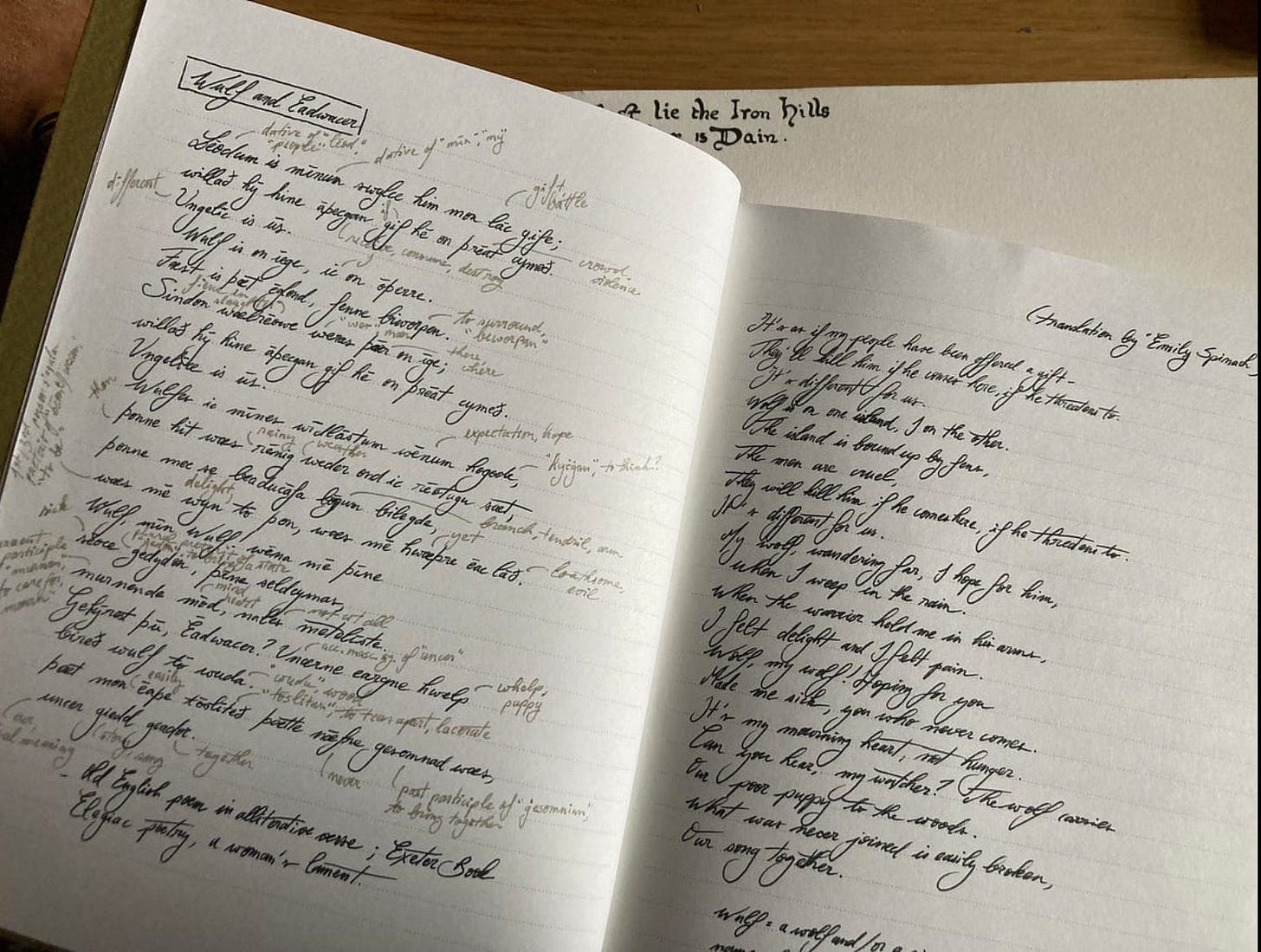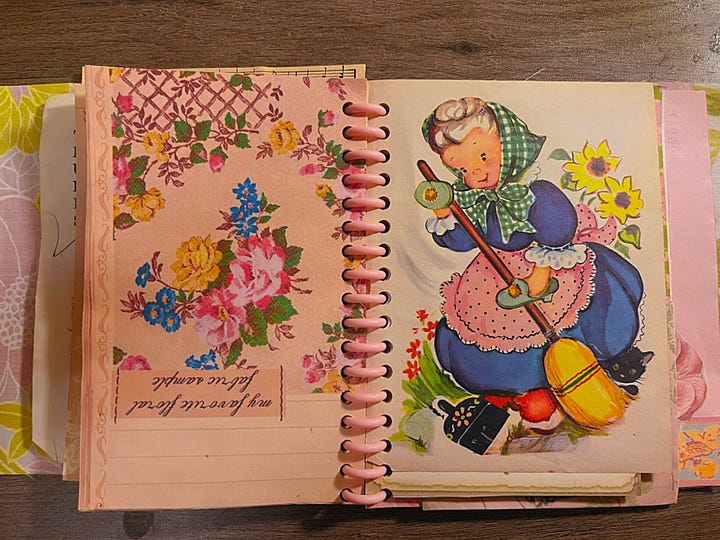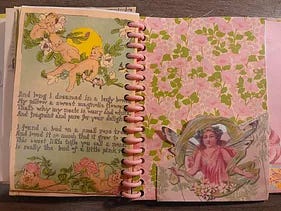It made me so happy to see y’all in the comments section of part I validating my struggles with starting/keeping a notebook and talking about your own journaling practices. After reading an excellent piece on building a personal archive, I’ve been thinking about different kinds of notebooks, their forms and functions. As I wrote in part I, I do love a notebook with no structure at all—a catch-all for whatever tidbits, lists and ramblings you care to record. But sometimes this total freedom can feel overwhelming, so I thought I’d follow up with a few different, more specific forms a notebook can take.

Commonplace Book
There’s so much commonplace book discourse out there that it feels hardly necessary to define, but just in case: a commonplace book is a place to copy down notable passages from other people’s work, like books, essays, songs, poems, or whatever else catches your attention. Sometimes they collect information relating to a specific theme or themes, sometimes—and I think, more commonly—they're just a hodgepodge. The useful thing about the latter version is that it becomes a record of your own thought and how it evolves, revealing connections between the unlikeliest subjects. I’m a firm believer in the validity of the weird jumps your mind makes, even when those correlations might not make sense to anyone else. For example, in an old one of mine I found the opening lyrics of Laurie Anderson’s O Superman right before a passage about the panopticon effect, which I guess—though I didn’t write this down, so who’s to say—I thought were related by themes of internalized control. Or maybe it was just stuck in my head. My problem with past commonplaces is that I never wrote down the connective tissue, so when I return to them I’m confounded as to how those two things were ever congruent in my mind, so I’d recommend at least a smidge of annotation.
Hypomnema
The great-granddaddy of the commonplace book, hypomnemata have their origins in Ancient Greece, when they were used to record reminders, notes, public records, commentaries, anecdotes, and any other significant information for future reference. I was introduced to them in undergrad, and kept them in running Word documents where I’d dump anything and everything I found interesting, stitching my own ideas and interpretations around them in red type, like I was Jesus or something. It was an invaluable note-taking practice that I promptly abandoned for no good reason upon graduating. As I relearned just now by looking back on those old hypomnemata, Michel Foucault wrote about this form of “self writing” in Ethics: Subjectivity and Truth, stating that it wasn’t meant “to pursue the unspeakable, nor to reveal the hidden, nor to say the unsaid, but on the contrary to capture the already said, to collect what one has managed to hear or read, and for a purpose that is nothing less than the shaping of the self.” So, like the commonplace, it’s a spot to collect information that comes from outside of the self—and if Foucault is to be believed, the process of collection is a means of self-creation as much as it is a documentary process. I think of both hypomnemata and commonplace books as a kind of compost heap of ideas, where sometimes, if you’re lucky, you might find a pumpkin has grown unbidden.


Junk Journal
The more tactile cousin of the commonplace book and hypomnema, the junk journal collects physical rather than mental ephemera. Like commonplaces, junk journal spreads can have any theme or no theme—a color, a day in the life, a meal, a mood. What interests me most about them is the opportunity to narrativize the sediment of everyday life. A scrap of wrapping paper? When you juxtapose it with the stamp from a friend’s thank-you note, it tells the story of a gift. A pressed flower and a coffee shop receipt? You’ve got the story of a walk in springtime. I’ve never tried junk journaling, but I keep an envelope of paper oddities that’s spilled over into an auxiliary empty lettuce clamshell, so maybe it’s time for me to start.
Silva Rerum
A new one to me, the silva rerum was a form of multi-generational chronicle kept by Polish and Lithuanian noble families in the 16th through 18th centuries. The literal translation is a “forest of things,” which is a lovely and apt description of the dark and rambling process of recording everyday archives. The collective version of a commonplace book, silvae rerum reflect a family history: traditions, lore, recipes, secrets.
I absolutely love this idea of a continuous narrative constructed by a family through generations, offering a record of a life created together; a history of the good and the bad. Oddly, the only example of something like this I can think of has a pretty grim context: the 2017 psychological horror film Marrowbone, in which the Marrowbone family co-create a diary recording their family life, which ultimately reveals a devastating secret. It’s a gorgeous film, and the thing that really struck me about the silva rerum-ish diary was the form it took: sketches and watercolor paintings illustrating the text, bound in a hand-embroidered cover. This multimedia approach seems apropos for creating a “forest of things.”
I would love to see the idea of a collective journal revive among a family, a chosen family, a friend group, or even a single friendship. There’s so much value to the everyday labor of creating a life, a relationship, and that daily work deserves to be recorded.
So…much as I love the idea of having a meticulously organized, multi-notebook system complete with indexes, themes, cross-referencing and color-coding, I know myself well enough to recognize that it would be of no use to me because I would instantly lose several of those notebooks among different tote bags and coat pockets, and the whole thing would collapse like a house of cards. So instead, I’m implementing elements of the commonplace book, hypomnema, and junk journal into my single catch-all notebook, in hopes that this “regular and deliberate practice of the disparate,” as Foucault wrote, will reveal connections between unexpected things.
If any of y’all are long-time keepers of commonplaces, hypomnemata, junk journals or silvas(!), I would love to hear your tips and ideas!






As a chronically indecisive person with a horror of doing anything so permanent as actually taping or gluing my precious random scraps of paper, my "junk journal" is a three-ring binder with clear plastic sleeves where I preserve and order all the cards, letters and other various life paraphernalia that has sentimental value but I don't necessarily want to look at frequently (or not much sentimental value but I am likewise too indecisive to commit to throwing out)
I loved learning about the side shoots to the commonly-known commonplace book - they sound delightful and curiously alluring. I’ve kept an art journal which, when I look back on it, reminds me of a very particular slice of my life and evokes so many emotions. I have a collection of quotes from all kinds of people. I have a book that I bound myself (a proper, hardback book!) with disparate musings and images and snippets of tickets and tags and photos in it. I have all kinds of books that I tried to theme and I think I know now - theming is setting myself up to fail. So, I’m going to finish the unfinished ones with whatever I want, and it will take the time it takes.